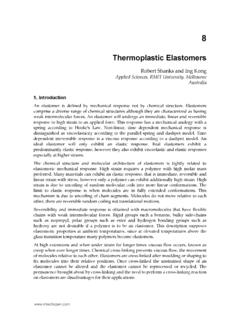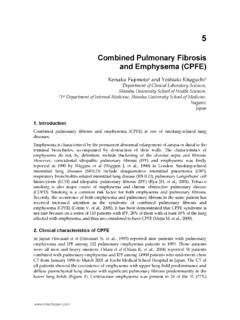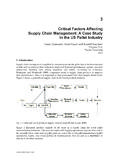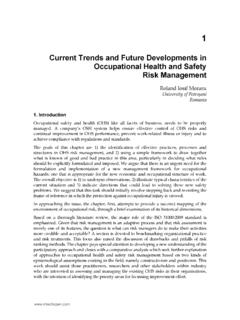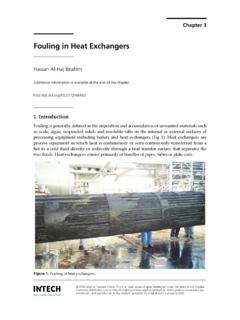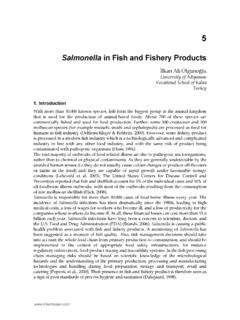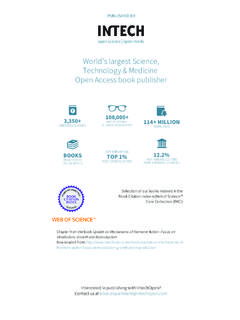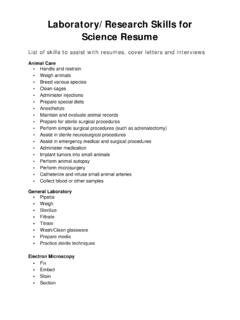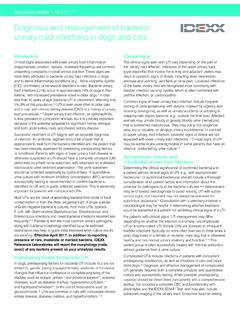Transcription of 91; ' # '8& *#9 & - InTech
1 3,350+OPEN ACCESS BOOKS108,000+INTERNATIONALAUTHORS AND EDITORS114+ MILLIONDOWNLOADSBOOKSDELIVERED TO151 COUNTRIESAUTHORS AMONGTOP 1%MOST CITED AND EDITORSFROM TOP 500 UNIVERSITIESS election of our books indexed in theBook Citation Index in Web of Science Core Collection (BKCI)Chapter from the book Applications and Experiences of quality ControlDownloaded from: BYWorld's largest Science,Technology & Medicine Open Access book publisherInterested in publishing with IntechOpen?Contact us at quality control in clinical laboratories Petros Karkalousos1 and Angelos Evangelopoulos2 1 Technological Institute of Athens, Faculty of Health and Caring Professions, Department of Medical laboratories 2 Lab Organization & quality control dept, Roche Diagnostics (Hellas) Athens Greece 1.
2 Introduction The automated analyzers in clinical laboratories Nowadays, the overwhelming majority of laboratory results in clinical laboratories is being generated by automated analyzers. Modern automated analyzers are highly sophisticated instruments which can produce a tremendous number of laboratory results in a very short time. This is achieved thanks to the integration of technologies from three different scientific fields: analytical chemistry, computer science and robotics. The combination of these technologies substitutes a huge number of glassware equipment and tedious, repetitive laboratory work. As a matter of fact, the laboratory routine work has diminished significantly.
3 Today laboratory personnel s duties have been shifted from manual work to the maintenance of the equipment, internal and external quality control , instrument calibration and data management of the generated results. Statistical quality control in industrial production quality control is an ancient procedure. For centuries manufacturers checked the quality of their products trying to find early any defect. At that time, manufacturers checked every product, one by one, without exception. Today, in industrial business, monitoring the quality of the each product is unattainable due to the large-scale production of different goods. Modern quality control is used to check the quality of a minimum number of samples from the total production.
4 The procedure is called statistical quality control (SQC) or statistical process control (SPC). SQC is faster and more efficient than single checking. The most general definition of SQC is: SQC is process that minimizes the variability of a procedure although it would be wiser to define SQC as The process that focuses on revealing any deviations from well defined standards . SQC in clinical laboratories automated analyzers SQC can be used in every automated production, like the laboratory determinations which are performed by biomedical analyzers. Unlike the industrial business where all products are similar, the laboratory determinations are totally different because of the huge biological differences among human beings.
5 As a result, SQC can be done only for the equipment and the analytical methods and rarely for each laboratory result. SQC of automated analyzers Applications and Experiences of quality control 332 uses as samples not the patients results but the results of some special samples, the control samples. The aim of this chapter is the introduction to the statistical quality control for automated analyzers in biomedical sciences such as haematology and biochemistry. The most important relevant laboratory SQC methods will be described. 2. Basic terms and definitions Types of laboratory errors and mistakes In laboratory practice many non-conforming results may appear. These results are divided in two major categories: Errors: Non-conforming results with statistical meaning.
6 This category includes all the wrong laboratory measures due to non-human action. Mistakes: Non-conforming results with no statistical meaning . This category contains all the human errors mixing up samples. Another classification of errors and mistakes is based on the time and the stage they appeared in laboratory practice. 1. The pre-analytical stage encompasses all the procedures which are take place before the analysis of the patients samples on the automated analyzers ( blood drawing, sample transportation, centrifugation, dilutions etc). 2. The analytical stage includes the analytical methods 3. The post-analytical stage refers to transmission of data from analyzers to the LIS, validation of results that have been produced and posting of the results to physicians or patients.
7 According to the previous classification, errors and mistakes are divided in three corresponding categories: I) pre-analytical, II) analytical, III) post-analytical. The majority of pre-analytical and post-analytical outliers are mistakes in contrary to analytical outliers which are considered as errors 1. Tables 1 3 contain a list of the most common errors in hematology and biochemical analyzers. Although many kinds of errors can be detected with various methods in laboratory practice, the laboratory staff focuses on detecting and eliminating the analytical errors. The reasons are: he analytical errors are attributed to the laboratory staff. The analytical errors can be detected with SQC methods. Statisticians have helped in establishing certain limits for the analytical errors for every laboratory determination.
8 1. Inappropriate specimen ( wrong specimen-anticoagulant ratio) 2. Wrong anticoagulant ( sodium citrate in place of EDTA) 3. Improper conservation method 4. Inappropriate patient s preparation ( wrong diet) 5. Mistakes in patients identification Table 1. Common pre-analytical errors 1 In this chapter, we will use the term errors for all kinds of outliers except special circumstances. control in clinical laboratories 333 1. Expired reagents which may lead to erroneous results 2. Expired controls or calibrators 3. Calibration curve time-out elapsed 4. Failure in sampling system 5. Failure in aspiration system of reagents 6. Changes in analyzer s photometric unit / flow cell / measuring unit 7. Any other analyzer s failure Table 2.
9 Common analytical errors 1. Wrong matching between sample and laboratory s files 2. Wrong copy of results from the analyzer s report to the laboratory report (in cases of manual transfer) 3. Delay in delivering the results to the physicians, clinics or patients 4. Loss of the results Table 3. Common post-analytical errors Precision and accuracy Analytical errors influence the repeatability, reproducibility, precision, trueness and accuracy of the analytical methods. Precision and accuracy can be defined with many different ways. 1st definition (EURACHEM/CITAC Guide CG 4) Precision is the closeness of agreement between independent test results obtained under stipulated conditions. Accuracy is the closeness of the agreement between the result of a measurement and a true value of the measurand.
10 According to the same guide true value2 is the value consistent with the definition of a given quantity . In fact true value is any measurement with no errors random or systematic (see paragraph ). Measurand is a particular quantity subject to measurement or simply any substance or analyte which can be assayed in a clinical laboratory. 2nd definition Precision = repeatability or reproducibility3 (1) Accuracy4 = trueness + precision (2) 2 According to the EURACHEM/CITAC Guide CG 4 the indefinite article "a" rather than the definite article "the" is used in conjunction with "true value" because there may be many values consistent with the definition of a given quantity.


